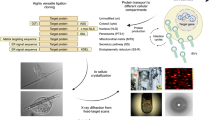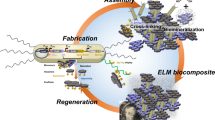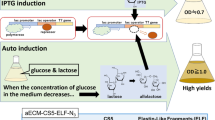Abstract
There has been an increasing interest in the use of immobilized cells for the production of pharmaceuticals as well as for products such as high fructose syrup or ethanol1. Some of these compounds are now produced on an industrial scale2 whereby the cells are used in a resting or growing state or in a nonviable form as natural carriers of the enzyme(s) involved in the synthesis. The advantages of immobilized cell technology should also apply to microorganisms modified by recombinant DNA techniques to produce a variety of eukaryotic proteins such as hormones. We describe here the properties of immobilized Bacillus subtilis cells carrying plasmids encoding rat proinsulin. Cell proliferation normally coupled to DNA replication is undesirable in immobilized cell systems as ‘clogging’ of the system occurs due to cells growing outside the beads. Therefore, different ways were investigated to inhibit cell division while allowing continued protein synthesis. We found that the addition of certain antibiotics in the growth medium, such as novobiocin which inhibits DNA replication3, fulfills these requirements, allowing proinsulin synthesis and excretion to take place over a period of several days.
This is a preview of subscription content, access via your institution
Access options
Subscribe to this journal
Receive 51 print issues and online access
$199.00 per year
only $3.90 per issue
Buy this article
- Purchase on Springer Link
- Instant access to full article PDF
Prices may be subject to local taxes which are calculated during checkout
Similar content being viewed by others
References
Mosbach, K. (ed.) Methods in Enzymology 44 (Academic, New York, 1976).
Chibata, I. in Food Process Engineering Vol. 2 (eds Linko, P. & Larinkari, J.) 1–26 (Applied Science, London, 1980).
Geliert, M., O'Dea, M., Itoh, T. & Tomizawa, J.-I. Proc. natn. Acad. Sci. U.S.A. 73, 4474–4478 (1976).
Talmadge, K., Stahl, S. & Gilbert, W. Proc. natn. Acad. Sci. U.S.A. 77, 3369–3373 (1980).
Neugebauer, K., Sprengel, R. & Schaller, H. Nucleic Acids Res. 9, 2577–2588 (1981).
Hardy, K., Stahl, S. & Kupper, H. Nature 293, 481–483 (1981).
Wikström, P., Szwajcer, E., Brodelius, P., Nilsson, K. & Mosbach, K. Biotechnol. Lett. 4, 153–158 (1982).
Nilsson, K. & Mosbach, K. Swedish Patent Application No. 8210041–0.
Freeman, A., Blank, T. & Aharonowitz, Y. Eur. J. appl. Microbiol. Biotechnol. 14, 13–15 (1982).
Brodelius, P. & Nilsson, K. FEBS Lett. 122, 312–316 (1980).
Palva, I. et al. Gene (in the press).
Author information
Authors and Affiliations
Rights and permissions
About this article
Cite this article
Mosbach, K., Birnbaum, S., Hardy, K. et al. Formation of proinsulin by immobilized Bacillus subtilis. Nature 302, 543–545 (1983). https://doi.org/10.1038/302543a0
Received:
Accepted:
Published:
Issue Date:
DOI: https://doi.org/10.1038/302543a0
This article is cited by
-
Magnetic immobilization of recombinant E. coli cells producing extracellular l-asparaginase II: evaluation of plasmid stability and interaction of nanoparticles with the product
Applied Physics A (2022)
-
Recombinant Streptomyces Lividans Secretes a Fusion Protein of Tendamistat and Proinsulin
Nature Biotechnology (1989)
-
Effect of antibiotics on lysine production in free and immobilized cells of Bacillus subtilis
Applied Microbiology and Biotechnology (1989)
Comments
By submitting a comment you agree to abide by our Terms and Community Guidelines. If you find something abusive or that does not comply with our terms or guidelines please flag it as inappropriate.



